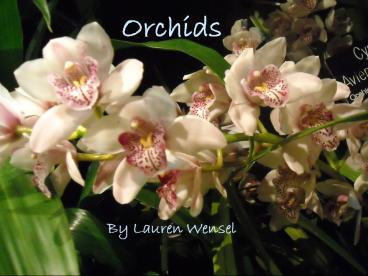Orchids PowerPoint PPT Presentation
Title: Orchids
1
Orchids
- By Lauren Wensel
2
Questions to Address.
- What are the different pollinators used by
orchids? - How does the Orchid attract pollinators?
3
Different Types of Pollinators
- Wingless Worker Ants
- Bees
- Butterflies
- Moths
- Flies
- Birds
4
Different Ways to Attract Pollinators
- Sexual deception
- Different fragrances
- Bright colors
5
Sexual Deception
- The Orchids can attract the male wasps by
releasing a chemical, 2-ethy-5-propylcyclohhexa-1,
3-dione, which is similar to that of a female - Found in the Australian Orchid, Chiloglottis
6
2-ethy-5-propylcyclohhexa-1,3-dione
7
Wasp Attractiveness
8
Another use of Fragrances
- The male euglossine bees are attracted to the
orchid smell for a different reason - When they visit they scratch and brush themselves
against the flower to get the scent - The bees collect the fragrance and store it in
their hind tibiae
9
Why do the male Euglossine Bees collect the
fragrance compound?
- They could use it for metabolic reasons
- The Males attract females with the scent and then
use their territorial displays to lure them in - Males use the scent to attract other males to a
mating site
10
Male Euglossine Bees
- Diagram of male bee
11
Future Research.
- In the future I think it would be interesting to
test which of the different types of pollinators
are best for orchid fertilization.
12
References
- Ackerman, J. D. Specificity and Mutual
Dependency of the Orchid- Euglossine Bee
Interaction. Biological Journal of the Linnean
Society.1983. Vol. 20. pp. 301-314. - Beattie, A. J., Peakall, R. Pollination of the
Orchid Microtis Parviflora R. Br. By Flightless
Worker Ants. British Ecological Society. Vol. 3.
No. 5. 1989. pp. 515- 522. - Calvo, Richard N. Evolutionary Demography of
Orchids Intensity and Frequency of Pollination
and the Cost of Fruiting. Ecology. Vol. 74. No.
4. June 1993. pp. 1033-1042 - Dobson, Calaway H., Dressler, Robert L., Hills,
Harold G., Adams, Ralph M., Williams, Norris H.
Biologically Active Compounds in Orchid
Fragrances. Science. Vol. 164. No. 3885. 13 June
1969. pp. 1243- 1249 - Nilsson, L. A. Orchid pollination Biology.
Trends in Ecology and Evolution. Vol. 7. No.8.
1992. pp. 255-259 - O Connell, Lisa M., Johnston, Mark O. Male and
Female Pollination Success in a Deceptive Orchid,
A Selection Study. Ecology. Vol. 79. No.4. June
1998. pp. 1246-1260 - Schiestl, Florian P., Peakall, Rod, Mant, Jim G.,
Ibarra, Fernando, Schulz, Claudia, Franke,
Stephan, Francke, Wittko. The Chemistry of
Sexual Deception in an Orchid- Wasp Pollination
System. Science. Vol. 302. 17 October 2003. pp.
437-438

